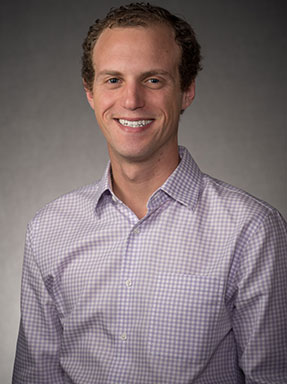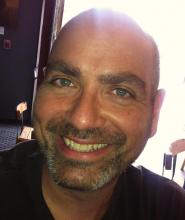Celebrating Latinx Heritage Month With Rafael Fajardo and Chris GauthierDickey
Carlos Moreno stands on one side of a pixelated, dotted-line border that splits an animated Rio Grande in half. The player controlling him moves Moreno up and back, side to side, with eyes on a small green sign that reads “VISA.”
To get there, the video game character has to cross the river and Interstate 10 Frogger style, dodging animals, debris, bodies, border agents, cars and helicopters.
In another game, the player is a Border Patrol agent, flinging handcuffs and even bullets at Moreno and other “alien invaders” who are trying to sneak through to the United States. “Catch as many as you can to be named agent of the month,” the instructions read.
“I think of them as raising attention, raising consciousness,” says Rafael Fajardo, an associate professor of emergent digital practices in the College of Arts, Humanities and Social Sciences.
He created the games in 2000 while teaching graphic design at the University of Texas-El Paso. Their purpose is to provide social commentary and culture critique.
Born in Colombia but raised in San Antonio, Fajardo had grown up with a blended culture and a desire to create. In his field, he noticed a Eurocentric pedagogy that, he felt, denied his heritage access to the field. As the internet began its boom, Fajardo felt primed to use the latest technology to create visual art and carve out a space for people like him.
Beginning Oct. 24, that space will be the Denver Art Museum, where a new exhibit, “ReVisión: Art in the Americas,” will allow visitors to play Crosser and La Migra. The exhibit links ancient and contemporary art to explore the political and social issues in the Americas from 100 B.C. to the present day.
Chris GauthierDickey, who chairs the Department of Computer Science at the Ritchie School of Engineering and Computer Science, updated Fajardo’s 20-year-old games and prepared them for display.
GauthierDickey, an expert in coding and game development, grew up in Laredo, Texas, and immediately saw the ways in which games can be more than simply entertaining.
“I think that you have an opportunity in humane games in particular to help people become more engaged and involved with a topic, instead of just listening to it passively,” he says. “You get this sort of interactive understanding and sort of feeling about what that topic is. I think it’s been really, really great.”
In celebration of Latinx Heritage Month, GauthierDickey and Fajardo discussed their work, the upcoming exhibit at the DAM and the way their art intersects with their identity.
What exactly are socially conscious humane video games? And why are they important?
Fajardo: The idea that a game, a video game in particular, might be socially conscious seems like an oxymoron. It sets up a cognitive dissonance. I was named to the board of advisors for an organization in New York called Games for Change. We wanted games to do good in the world.
“Games for Health” became one of the pillars of this humane games approach, where games can be palliative because they distract you from whatever ails you. But there are also games that are therapeutic — games where you’re blasting representations of cancer cells. It can actually provide some beneficial health outcomes to a cancer patient. There has been research around veterans who have PTSD with immersive virtual reality environments that help them process, cope and resume a normal life.
GauthierDickey: There’s a long history of games, period. But as people realized that games were worth a lot of money, [the industry] became massively commercialized. We’ve only recently seen this resurgence of independent developers who have gotten tired of being in the system.
Part of the problem with that commercialization is the focus. Nintendo realized that they had a huge market in young 13-year-old boys, and so they focused tremendously on this group. All of the protagonists became white male characters too. The reason that humane games are important is because you tend to get a representation that’s not just the typical white male protagonist who’s trying to kill a lot of things.
In my game programming class, I don’t focus a lot on game design, but I want [my students] to think in terms of humane games. For example, shortly after the big earthquakes in Haiti, I had two [student] games that really stuck out. One was a puzzle sort of game where your house had collapsed and you’re trying to move things around to escape. And these are games that people could make in 10 weeks, so it’s not like they’re these huge, complex games. But even just playing the game makes you think about how terrible that would be to go through.
In another one, you play a young Haitian child trying to escape [the country] by sailing a boat past drug dealers who are on the water. You have to do it very quietly. You have to stop. You have to hide. Eventually, you get to the end. And when you get to the end, it says, “Welcome to the United States. You win.” And it says, “You’re now being deported back to Haiti.”
That kind of thing is beautiful because you get into the moment of playing the game, like, “Oh, this is exciting. I’m sneaking around. I’m escaping. I finally made it to the United States to escape this horrible life I had.” And then you get deported back. It’s really saying something about what’s happening.
What is it like for the two of you as members of the Latinx community to be developing and creating these games that have the potential to touch pretty close to your hearts?
Fajardo: Now we’re 20 years down the road for Crosser, I think about 19 years down the road for La Migra. I’ve been super cautious. For La Migra in particular, I knew individuals who were members of the Border Patrol. I knew people who had family when we were living in El Paso. They would get used to a knee-jerk, disrespectful characterization. I really tried to inhabit the kind of conflicted feeling someone might have, because ICE and Border Patrol recruit from the regions where they serve. Everyone who lives along the U.S.-Mexico border has family on both sides.
I have no sympathy for the [agents] who are on horseback right now, carrying whips, let’s make that super clear. But there’s this other element that is deeply complicated, and we needed to understand that [a significant portion] of the Border Patrol happens to be Latinx, Chicanx, Hispanx, whatever they choose as an identity. That’s deeply conflicting. La Migra leaves the player with the choice of actively trying to stop crossers or stepping aside, turning a blind eye. It felt like the more complete story than Crosser all by itself. It needed to have this other vantage point.
Is there any added significance for you, partnering your academic artistic work with your Latinx heritage?
GauthierDickey: It’s been a way for me to help understand and recognize my own heritage. We both lived in border towns and have experienced that. It’s neat. It ties back into my experience growing up and just recognizing where I come from, and who I am, and who my family is. It’s been beautiful. It’s been wonderful for me to be able to share this with Rafael and talk.
Fajardo: I would echo Chris’s thoughts. When I did my graduate work, I started exploring cultural identity as sort of central to what my themes were going to be. So being able to do this through video games has been really, really important, to explore expressions of mine and other Latinx cultural identities.
Tell me a little bit about this exhibition that’s going up at the Denver Art Museum.
Fajardo: The Denver Art Museum has long had a pre-conquest collection. And they have long had a colonial- era collection of art from what we now know of as Latin America. Two curators decided to take another look at the 2,000 years of history represented in their collection and connect it with contemporary work. One of the curators saw Crosser and La Migra when it was in an exhibition at the Emmanuel Gallery in 2017. And saw a connection that she wanted to make, and so invited us to show Crosser and La Migra there.
What is super exciting for me is that our collaborative work gets to be part of this narrative of 2,000 years of art history from this continent from the North and South Americas, if we’re going to use the contemporary terms for describing the region. That’s just huge. I actually cried when I received the invitation. The work is coequal with anthropological and archaeologically significant works, coequal with fascinating art from the colonial period, coequal with other art forms. And for games, this has long been a weird argument, a weird insecurity, right?
GauthierDickey: Yeah, absolutely. Can games be art is always the question. I think we’re getting to a point in time where we’re understanding that games are not defined by Nintendo’s vision in the ‘80s of games for 13-year-old boys. There is some meaning beyond just button mashing, and there is very much so an artistic nature to games and the creative aspect and the building of these. I think that’s also why it’s significant, especially for us.
Fajardo: What makes game special is that you have to play them to understand them. There’s a certain kind of cognition, certain kind of realization that happens through the gesture of the gameplay that you don’t get from the other media.
What do you hope the people who come to the exhibit and play this game take away?
Fajardo: That one’s really hard. That kind of question, I think, leads from a marketing point of view. An art sensibility doesn’t always ask that question. So if we were going to call it a takeaway, then the sort of raising of consciousness about what life on the border might be like, what it is to embody through your avatar trying to help someone across the Rio Grande and across I-10. The fact that this was originally crafted 20 years ago and still seems to be a crucial part of our cultural dialogue, the fact that human migratory patterns are as old as humans and humanity —those artificial boundaries and borders that we erect are actually sort of contradicting those natural influences.
GauthierDickey: I think the beauty of what this is going to be is that it’s going to be in the context also of all of this art history. I hope that they’ll think, “OK, art is not totally Eurocentric. We have all of this art history from all of the Americas.” Then, to see and maybe somehow feel or understand how this art applies. Even though it was done so long ago, it still applies now and, like Rafael was saying, has applied for many hundreds of years.
What are you thinking about during Latinx Heritage Month? And what should those of us who do not share that heritage think about?
Fajardo: I’m always conflicted about the heritage months and the affinity months because I live this 12 months of the year, 52 weeks of the year. We can remember that we’re not a monolith. We are multiple, even though we share the language of two colonizers.
There are differences as well as similarities [between us]. There’s a richness, I guess, that’s worth the exploration. I tend to think [Latinx Heritage Month] falls in September because of Dieciseis [Mexican Independence Day]. It foregrounds a Mexican heritage, but the liberation of Central and South America from the Spanish colonial period could be celebrated many months of the year. Then, the indigeneity of those regions also still needs to be uplifted as well, rather than be erased.
GauthierDickey: As the old famous saying says, variety’s the spice of life. We aren’t a monolith. We are different people. We all are. We all have backgrounds and heritages, and they’re beautiful in their own ways. They have their own traditions, and their own foods, and their own histories that are good to remember because they make us who we are, and they give us different viewpoints and just maybe hopefully help us understand that that’s OK and that’s wonderful. It would be really boring if we were all the same. I guess that’s what I think about, and family a lot, especially.





